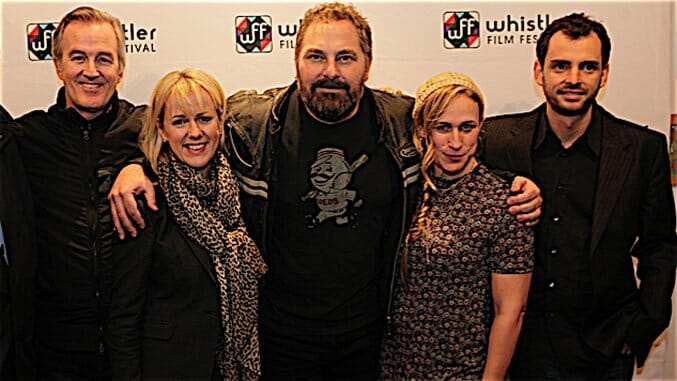Finding a Variety of Voices at the Whistler Film Fest
We talk with some of the screenwriters on the trade publication’s annual Top 10 Screenwriters to Watch
Photo courtesy Whistler Film Festival (l-r: Luke Davies, Jojo Moyes, Todd Komarnicki, Pamela Ribon and Jonás Cuarón)
“The stories we tell, it’s not just entertainment—far from it.It’s cultural markers, it shapes our memories, and it shapes who we can become,” said screenwriter Todd Komarnicki (Sully) to a packed room of listeners at Variety’s annual Top 10 Screenwriters to Watch panel that took place at the Whistler Film Festival on Dec 3rd.
It’s the festival’s 16th year, and aside from luring film industry types to the slopes for some schmoozing, deal-making, panels and skiing, WFF celebrates independent films, many of which are Canadian. It doesn’t, however, completely shy away from Hollywood. The festival opened with what is considered by many to be a front-runner for the Oscars, Damien Chazelle’s ode to movie musicals La La Land, starring Emma Stone and Ryan Gosling.
Of course, when speaking of Oscars, you might find at least a few of Variety’s scribe picks amongst the nominees come February 26, 2017. Of the 10 to Watch, five had made the trek to Whistler: Luke Davies (Lion), Pamela Ribon (Moana), Jojo Moyes (Me Before You), Todd Komarnicki (Sully) and Jonás Cuarón (Desierto). All of them distinctly different.
Moyes, who has written as many as 12 novels, recalls her quintessential L.A. experience going to a meeting with MGM about adapting Me Before You. She did what she cheekily refers to as “the full Brigitte Jones.” She bought a posh jacket, but inconveniently, the button popped off at airport security.
“But you don’t understand, I have a meeting. I can’t go in without a button,” she tried to reason with the officer. “Move along ma’am,” he barked. The scene repeated, until she said, “I’m going to a meeting in hollywood.” That’s when everything changed. “Hold on, find the button, find the button!” he yelled. “This is why I love Americans,” Moyes says.
At the meeting, Moyes was offered the project. “I’m one of those people who can think of a million reasons to say yes before saying no, so I said yes and set in an Uber they provided to go home going, ‘What have I just done?’,” she recalls. “They’ve created a monster cause I’ve gone on to do more since.”
The film, which coincidentally had a largely female team, including director Thea Sharrock, went on to make a lot of money for the studio. “I had no idea about the stats for women directors,” says Moyes, “and it was just really nice that a) it worked as a film, and b) it made the studio a lot of money because hopefully that will encourage people to think more positively about employing women in positions of creative power.”
Pamela Ribon has her own memories of taking pitch meeting—whilst pregnant. She’d maneuver around her obvious baby bump, trying to (often comically) hide it with pillows. Unable to ask her about her pregnancy directly, they’d ask: “So … what’s new?” To which she’d respond, without missing a beat: “Loving bagels!” Her baby was four months old when she began working on Moana—that baby is now four years old. “It was a very long labor of love,” she quips. Ribon has many more on the way: A sequel to Wreck-It Ralph, Smurfs: The Lost Village and even a series of comic books set in the world or roller derby—an activity she highly recommends for those wanting to learn how to survive in the entertainment industry.
Keeping your voice is a big part of it.
“If you’re going to make something stick, you’ve got to have your voice, you can’t have the voice of a thousand people,” says Komarnicki, who finds himself drawn to the untold stories. “There’s always a secret behind a secret,” he says. Whilst Sully (played by Tom Hanks) was being hailed as a hero in the press, no one knew what was going on with the investigation.
It was essential for Sully to use the right voice to tell the real story.
-

-

-

-

-

-

-

-

-

-

-

-

-

-

-

-

-

-

-

-

-

-

-

-

-

-

-

-

-

-

-

-

-

-

-

-

-

-

-

-








































